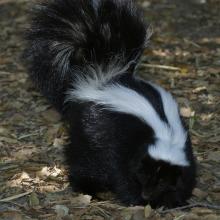Mephitis mephitis

Conservation Status:
Least Concern
Range:
Central Canada to Northern Mexico
Habitat:
Forests, grassy plains, agricultural land, and even urban areas
The Striped Skunk is a highly adaptable mammal species found in a range of habitats. When living in a den, skunks line their homes with grass, leaves, and sometimes hay for insulation. With the expansion of human-created environments they have adapted to living under porches, houses, and garages.
Skunks have an omnivorous diet and are considered opportunistic feeders, adjusting their food sources as needed. They can consume a variety of items, including fruits, leaves, bugs, small land animals, carrion, and fish. This adaptability in their diet allows them to survive and thrive in different environments.
Typically, skunks live solitary lives, with brief periods of interaction during the mating season. Mating occurs in early spring, usually from February through March. The gestation period lasts 59 to 77 days, and a female skunk can give birth to a litter of 2 to 10 young, known as kits. However, the survival rate of young skunks is relatively low, mainly due to disease and extreme weather conditions. At around two months old, the kits start learning to hunt and forage by following their mother in a single file. The characteristic skunk scent is present at birth, and kits can emit it around eight days old.
Striped Skunks possess enlarged scent glands that contain a potent musk. When threatened, they can discharge this musk in a fluid spray, reaching up to 6 meters. They have bold colours that warn of this chemical defense, and they will give behavioural warnings like stomping their feet and raising their tail in a handstand. The musk's powerful odor can cause nausea, intense pain, and temporary blindness, serving as a defense mechanism against potential predators.
Skunks face predation from native predators such as bobcats and birds of prey. Additionally, they have been historically threatened by the fur industry. However, due to their wide distribution and increasing abundance in many regions, they are currently listed as Least Concern on the IUCN Red List.
In their natural environment, skunks have a lifespan of about 3 to 5 years. However, when cared for by humans, they can live up to around 10 years, enjoying a longer lifespan due to reduced predation risks and access to consistent food sources.
